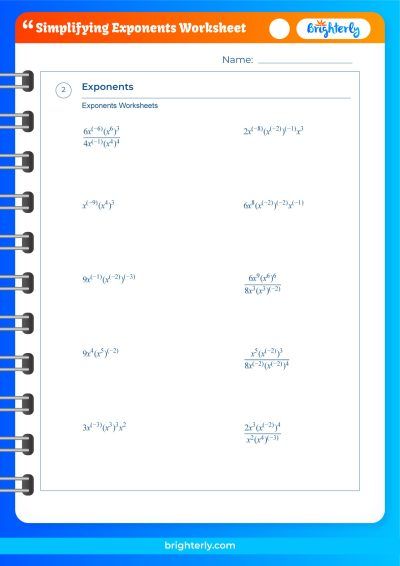Simplifying Exponents – Rules, Definition With Examples
Created on Dec 19, 2023
Updated on January 13, 2024
Welcome to Brighterly’s comprehensive guide to understanding and simplifying exponents! Exponents are integral in mathematics, providing a unique way to view multiplication and powers. They open up exciting pathways to explore more advanced concepts in algebra, calculus, and beyond. At Brighterly, we believe in making math fun and accessible for children, and this guide will break down the world of exponents into easy-to-understand definitions, rules, and examples. Whether you’re a student eager to learn or a parent looking to support your child’s mathematical journey, this guide has something for everyone.
What Are Exponents?
Exponents are an essential concept in mathematics, especially when dealing with multiplication of numbers by themselves. When a number is multiplied by itself a specific number of times, we use an exponent to represent this operation. For example, 34 means . In this expression, 3 is called the base, and 4 is the exponent.
Children often find this notion intriguing, as it introduces a new way of looking at multiplication. For instance, can be visualized as a small cube built from eight smaller cubes. It opens up the fascinating world of geometry and spatial reasoning. This concept not only simplifies multiplication but also serves as a building block for more complex mathematical theories.
Definition of Exponentiation
Exponentiation is the mathematical process of finding the result when a number, known as the base, is multiplied by itself a specific number of times, represented by the exponent. It’s a method that makes multiplication of the same number more efficient and concise.
In mathematics, the expression is read as “a to the power of n,” where ‘a’ is the base, and ‘n’ is the exponent. For example, 24=. This operation extends to negative exponents, fractions, and even irrational numbers. The realm of exponentiation is vast and fundamental to various mathematical disciplines, such as algebra and calculus.
Definition of Simplifying Exponents
Simplifying exponents means reducing expressions involving exponents to their simplest form. It makes calculations more straightforward and expressions easier to understand.
For instance, given an expression like 32×, you can simplify it using the rules of exponents as 36=729. By simplifying exponents, mathematics becomes more accessible, especially when dealing with larger numbers or complex expressions. This concept lays the foundation for higher mathematics, including polynomials and equations.
Properties of Exponents
Exponents have specific properties that govern how they work. These properties help to simplify mathematical expressions:
- Product of Powers:
- Quotient of Powers:
- Power of a Power:
- Power of a Product:
- Zero Exponent Rule:
These properties lay the groundwork for understanding the rules and methods used in simplifying exponents.
Properties of Simplifying Exponents
Just as exponents themselves have properties, the process of simplifying exponents also adheres to certain principles. These include:
- Combining Like Terms: Expressions like can be simplified to .
- Using the Zero Exponent Rule: Expressions such as 50 simplify to 1.
- Applying Negative Exponent Rules: A negative exponent like is equal to .
Understanding these principles helps in applying the rules for simplifying exponents, making mathematical expressions more manageable.
Rules for Simplifying Exponents
Here are the most common rules for simplifying exponents:
- Use the Product of Powers rule: .
- Use the Quotient of Powers rule: .
- Simplify using the Power of a Power rule: (.
- Reduce using the Power of a Product rule: (.
These rules make it easier to simplify expressions involving exponents, enhancing efficiency in mathematical operations.
At Brighterly, we believe that practice is the key to mastery. That’s why we invite you to explore our simplifying exponents worksheets, where you can find an array of additional practice questions, complete with answers.
Difference Between Exponentiation and Simplifying Exponents
Exponentiation is the process of multiplying a number by itself a specific number of times, whereas simplifying exponents refers to the method of reducing expressions involving exponents to their simplest form.
While exponentiation focuses on the process, simplifying exponents emphasizes making that process more understandable and manageable. They are two sides of the same coin, with exponentiation forming the concept and simplifying exponents offering the tools to work with that concept efficiently.
Methods and Techniques for Simplifying Exponents
The methods and techniques for simplifying exponents are grounded in the rules and properties previously discussed. Here’s how you can approach it:
- Identify Like Terms: Look for bases that are the same and apply the product or quotient of powers rules.
- Use the Zero and Negative Exponent Rules: Apply these rules where necessary to simplify expressions.
- Work with Fractional Exponents: Understand how to simplify expressions with fractions in the exponent, using the root of the base.
These methods and techniques make working with exponents more accessible, especially in algebraic expressions.
Practice Problems on Simplifying Exponents
Want to test your understanding? Try these practice problems:
- Simplify 23.
- What is 50?
- Simplify (32)3.
- Simplify 4-2.
- What is (2×3)4?
These problems will help reinforce the concepts, rules, and methods discussed in this article.
Conclusion
Simplifying exponents doesn’t have to be a complex or daunting task. Here at Brighterly, we’ve broken down this essential mathematical concept into bite-sized pieces that are both engaging and informative. We hope this guide has illuminated the path to understanding exponents, making it an enjoyable experience for children and adults alike. Keep exploring with Brighterly, and open the doors to a brighter and more enriching mathematical future. Remember, math is not just numbers and rules; it’s a language of logic and creativity waiting to be mastered.
Frequently Asked Questions on Simplifying Exponents
What is an exponent?
An exponent is a number that shows how many times a base number is multiplied by itself. It’s written as a small numeral above and to the right of the base number, such as in 23, where 2 is the base, and 3 is the exponent, meaning 2×2×2=8.
What does simplifying exponents mean, and how does it relate to Brighterly’s approach to math?
Simplifying exponents means reducing expressions with exponents to their simplest form, following specific rules and properties. At Brighterly, we teach this concept by breaking down complex ideas into engaging and easy-to-understand examples, making math more approachable and fun.
Why is understanding exponents important in mathematical education for children?
Understanding exponents is crucial as it serves as a foundational concept for higher mathematics. It helps in teaching logical thinking and problem-solving skills. For children, it’s an essential stepping stone that prepares them for more complex mathematical theories.
How can parents help their children understand the concept of exponents?
Parents can support their children by encouraging them to practice and explore various examples. Using visual aids, such as building blocks to represent the multiplication of numbers, can make the concept more tangible. Brighterly offers resources and guides that parents can utilize to make learning exponents an engaging experience.
Where can I find more resources for teaching or learning about exponents?
Brighterly is dedicated to providing high-quality educational materials. You can find more resources on our website, including interactive exercises, detailed guides, and video tutorials tailored to different age groups and learning levels.






